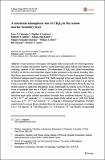Por favor, use este identificador para citar o enlazar a este item:
http://hdl.handle.net/10261/163220COMPARTIR / EXPORTAR:
 SHARE SHARE
 CORE
BASE CORE
BASE
|
|
| Visualizar otros formatos: MARC | Dublin Core | RDF | ORE | MODS | METS | DIDL | DATACITE | |

| Título: | A nocturnal atmospheric loss of CH2I2 in the remote marine boundary layer |
Autor: | Carpenter, L.J.; Andrews, S.J.; Lidster, R.T.; Saiz-Lopez, A. CSIC ORCID; Fernández-Sánchez, Miguel CSIC ORCID; Bloss, W.J.; Ouyang, B.; Jones, R. L. | Fecha de publicación: | 2017 | Editor: | Kluwer Academic Publishers | Citación: | Journal of Atmospheric Chemistry 74: 145- 156 (2017) | Resumen: | Ocean emissions of inorganic and organic iodine compounds drive the biogeochemical cycle of iodine and produce reactive ozone-destroying iodine radicals that influence the oxidizing capacity of the atmosphere. Di-iodomethane (CHI) and chloro-iodomethane (CHICl) are the two most important organic iodine precursors in the marine boundary layer. Ship-borne measurements made during the TORERO (Tropical Ocean tRoposphere Exchange of Reactive halogens and Oxygenated VOC) field campaign in the east tropical Pacific Ocean in January/February 2012 revealed strong diurnal cycles of CHI and CHICl in air and of CHI in seawater. Both compounds are known to undergo rapid photolysis during the day, but models assume no night-time atmospheric losses. Surprisingly, the diurnal cycle of CHI was lower in amplitude than that of CHICl, despite its faster photolysis rate. We speculate that night-time loss of CHI occurs due to reaction with NO radicals. Indirect results from a laboratory study under ambient atmospheric boundary layer conditions indicate a k of ≤4 × 10 cm molecule s; a previous kinetic study carried out at ≤100 Torr found k of 4 × 10 cm molecule s. Using the 1-dimensional atmospheric THAMO model driven by sea-air fluxes calculated from the seawater and air measurements (averaging 1.8 +/− 0.8 nmol m d for CHI and 3.7 +/− 0.8 nmol m d for CHICl), we show that the model overestimates night-time CHI by >60 % but reaches good agreement with the measurements when the CHI + NO reaction is included at 2–4 × 10 cm molecule s. We conclude that the reaction has a significant effect on CHI and helps reconcile observed and modeled concentrations. We recommend further direct measurements of this reaction under atmospheric conditions, including of product branching ratios. | URI: | http://hdl.handle.net/10261/163220 | DOI: | 10.1007/s10874-015-9320-6 | Identificadores: | doi: 10.1007/s10874-015-9320-6 issn: 1573-0662 |
| Aparece en las colecciones: | (IQF) Artículos |
Ficheros en este ítem:
| Fichero | Descripción | Tamaño | Formato | |
|---|---|---|---|---|
| s10874-015-9320-6.pdf | 1,32 MB | Adobe PDF |  Visualizar/Abrir |
CORE Recommender
SCOPUSTM
Citations
4
checked on 16-abr-2024
WEB OF SCIENCETM
Citations
5
checked on 26-feb-2024
Page view(s)
297
checked on 22-abr-2024
Download(s)
170
checked on 22-abr-2024
Google ScholarTM
Check
Altmetric
Altmetric
NOTA: Los ítems de Digital.CSIC están protegidos por copyright, con todos los derechos reservados, a menos que se indique lo contrario.
